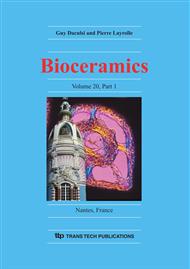p.1153
p.1157
p.1161
p.1165
p.1169
p.1173
p.1177
p.1181
p.1185
Behavior of Cellularized-Hydroxyapatite Implants Coated with Cyclo-DfKRG Peptides in Spongious Bone: Quantitative Comparison of Micro-Tomodensitometry and Histomorphometry
Abstract:
In order to develop bone substitute with osteogenic properties, a novel strategy of grafting cyclo-DfKRG peptides to enhance cells adhesion and osteointegration of hydroxyapatite (HA) implants was developed. Objectives of the study were (1) to evaluate the osteogenic properties of HA implants grafted with RGD peptides and (2) to compare histomorphometry and micro-computed tomography ((CT) with bone quantification. Pure HA grafted or not with cyclo- DfKRG peptides and autologous stromal cells was implanted in femoral condyle on 2 groups (2 and 4 weeks) of 6 New Zealand rabbits. Measurements concerning bone reconstruction and material structure were obtained with a (CT and the results were compared to those obtained after histomorphometry. Finally, it appears that grafting cyclo-DfKRG on HA implants enhances nonsignificantly the rate of bone formation, and a high correlation of the results was found comparing histomorphometry and (CT analysis.
Info:
Periodical:
Pages:
1169-1172
Citation:
Online since:
November 2007
Price:
Сopyright:
© 2008 Trans Tech Publications Ltd. All Rights Reserved
Share:
Citation:


